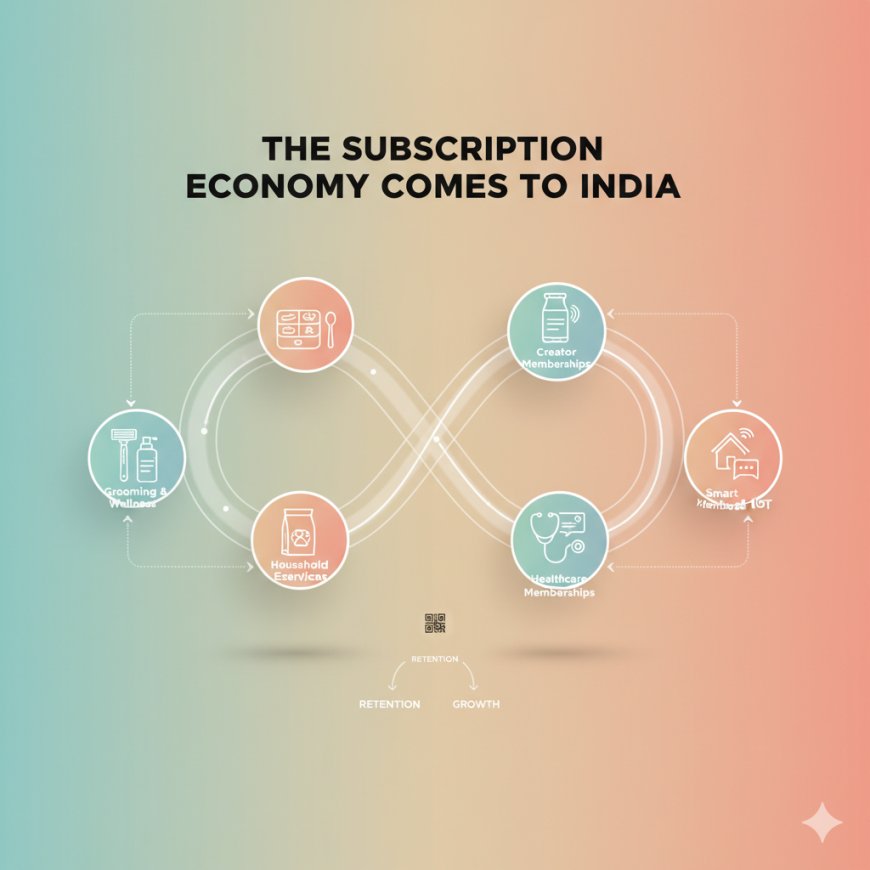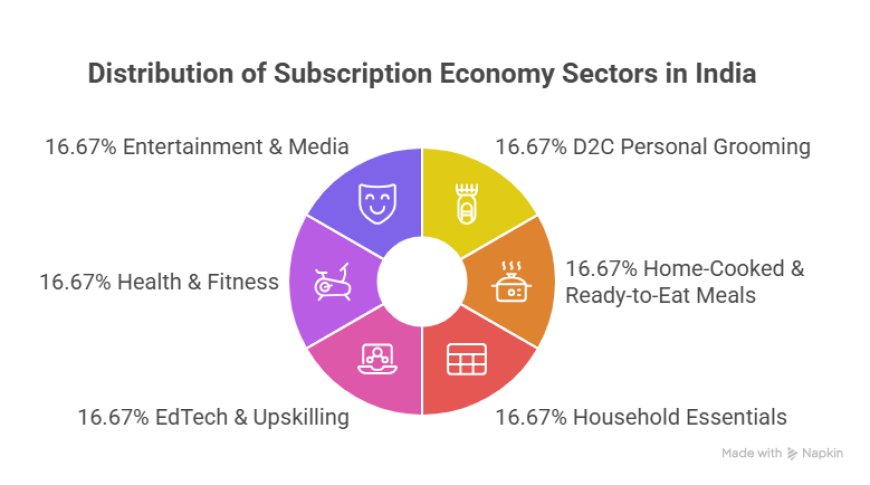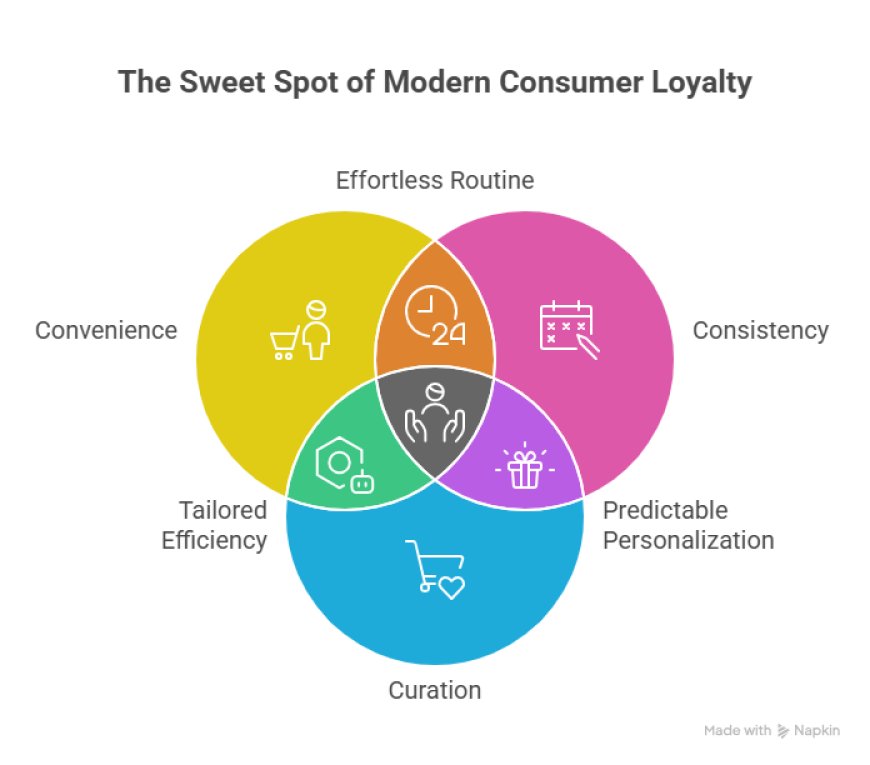The Subscription Economy Comes to India
Discover how India’s subscription economy is booming—from grooming and meals to healthcare and creator communities—and why recurring revenue is shaping the future of brands.

India is undergoing a subtle but powerful shift in how people buy everyday products and services. The old cycle of one-time purchases driven by discounts and impulse buying is giving way to a new behavior pattern: predictable, recurring consumption.
From grooming essentials to home-cooked meals, medicines, cleaning supplies, and even online learning — consumers are increasingly choosing models that offer convenience, consistency, and guaranteed value. Instead of deciding each month what to buy, many now prefer “set-it-and-forget-it” experiences where quality and delivery are assured.
Globally, subscription and membership models have seen massive adoption. Yet in India, the boom is unique because it comes with regional preferences, price sensitivity, and cultural nuances. Meal subscriptions are inspired by local cuisines. Beauty and wellness memberships are hyper-personalized. Healthcare subscriptions cater to chronic care and preventive diagnostics.
At the heart of it, the subscription economy is not just a trend — it is a business strategy. Subscriptions give brands predictable monthly revenue, higher customer lifetime value (LTV), and deeper retention. For consumers, they eliminate friction and bring order to daily life.
Core idea:
Subscriptions = recurring revenue + loyalty flywheel → a powerful and sustainable growth engine for Indian brands.
Why Subscriptions Work in the Indian Market
India’s landscape is perfectly primed for the subscription economy to thrive. A combination of demographic, technological, and behavioral factors has created fertile ground for recurring-purchase models.
First, India’s rising middle class and young working population value time, convenience, and reliability. As disposable incomes grow and lifestyles become busier, people are willing to pay for services that reduce decision fatigue.
Second, the country now has one of the world’s most advanced digital transaction ecosystems.
- UPI makes recurring payments seamless.
- E-commerce and quick-commerce platforms have normalized doorstep delivery.
- Logistics networks now reach deep into Tier-2 and Tier-3 cities.
This infrastructure removes the friction that once slowed subscription adoption.
The pandemic created another behavioral inflection point. With people at home and mobility restricted, millions developed a preference for home delivery, scheduled replenishment, and low-touch ordering. That habit didn’t fade — it evolved.
And finally, there is a trust shift. Indian consumers increasingly expect predictability: same-day delivery, consistent product quality, curated selections, and proactive service. Subscriptions deliver exactly that.
Together, these factors make India a prime environment for long-term subscription behaviors to take root — and for brands to grow through reliable, recurring demand.
Key Sectors Driving India’s Subscription Wave
The subscription economy is not limited to digital entertainment anymore — it is reshaping everyday consumption across urban and semi-urban India. Multiple sectors are experiencing strong adoption, each driven by convenience, consistency, and personalization.
D2C Personal Grooming
Brands offering razors, skincare, haircare, supplements, and wellness boxes are seeing steady subscription growth.
Why it works:
· Consumers avoid last-minute purchases
· Personalized routines delivered monthly
· Value bundles feel cost-effective
Subscription grooming becomes a lifestyle, not a monthly chore.
Home-Cooked & Ready-to-Eat Meals
Cloud kitchens, healthy meal plans, and tiffin services now run on subscription-first models.
What drives demand:
· Busy working professionals
· Consistency of taste and nutrition
· Regional cuisine clubs creating cultural familiarity
Food subscriptions have become India’s most culturally adapted recurring service.

Household Essentials
Cleaning liquids, detergents, pet food, diapers, and kitchen staples are shifting to replenishment subscriptions.
Reason: predictable usage + predictable delivery.
UPI-based recurring payments make this seamless for families and bachelors alike.
EdTech & Upskilling
EdTech 2.0 is subscription-heavy: microlearning, exam prep, cohort communities, and mentorship-based memberships.
This ensures:
· Continuous learning
· Affordable access
· Stronger learner engagement
Subscriptions help platforms build long-term learner relationships.
Health & Fitness
Healthcare subscriptions are booming:
· Telemedicine memberships
· Preventive diagnostics packages
· Repeat chronic-care prescriptions
· Fitness and meditation apps
These bring affordability, regularity, and proactive health management.
Entertainment & Media
OTT platforms, creator communities, and premium newsletters pioneered India’s early subscription habits.
With rising digital consumption, people willingly pay for:
· Ad-free entertainment
· Exclusive content
· Deep-dive newsletters
· Community access
Together, these sectors show one clear pattern: subscription habits are becoming embedded in daily life.
The Business Model: From Transactions → Relationships
Subscription-first companies do not sell products — they build relationships. This marks one of the biggest business-model shifts in India’s consumer landscape.
Subscription Economics: Predictable → Scalable
· Predictable recurring revenue
· Higher retention rates
· Lower customer acquisition cost (CAC) over time
· Better ability to forecast demand and inventory
Brands evolve from short-term sales tactics to long-term revenue stability.
Personalization Fuels Stickiness
The more a brand understands a customer’s routine and preferences, the more indispensable it becomes.
India’s Emerging Subscription Categories (Detailed)
India’s subscription economy is evolving beyond OTT platforms and grooming kits — it’s expanding into food, healthcare, creator ecosystems, and even home automation. Here’s a closer look at the categories shaping the next wave:
Grooming & Wellness: Beardo, Bombay Shaving Co., Pilgrim
Personal grooming brands have become pioneers of the subscription model in India, especially among young urban consumers.
• Beardo and Bombay Shaving Co. offer razor blade refills, beard care kits, and skincare subscriptions tailored to routine grooming cycles.
• Pilgrim uses data to curate skincare regimens delivered monthly or quarterly, driving repeat usage and habit formation.
Why it works: predictable replenishment, bundle value, and personalized curation.
Meal Subscription Startups: iD Fresh, EatFit & Regional Cloud Kitchens
• iD Fresh Food offers recurring delivery of batters, parotas, and breakfast essentials — ideal for busy households.
• EatFit provides calorie-counted meals, wellness diets, and “meal-of-the-day” subscriptions.
• Hundreds of local cloud kitchens now run recurring meal plans for office-goers and families, offering convenience with home-style taste.
Why it works: health, convenience, and reliable quality — all wrapped in predictable delivery cycles.
Tiffin 2.0: Curated Regional Meal Plans
Traditional dabba services have evolved into curated subscription-led offerings:
• Regional cuisine clubs offering “Gujarati thali week,” “South Indian home kitchen menu,” or “Bihari comfort meals.”
• Diet-specific options like high-protein, diabetic-friendly, and low-carb tiffins.
These appeal to young professionals migrating for work, craving the comfort and consistency of home-cooked meals.
Healthcare Memberships: Cult.fit, Tata 1mg Care Plans, Pharmacy Packs
Healthcare is one of the fastest-growing subscription categories:
• Cult.fit offers holistic fitness and wellness memberships blending gym access, home workouts, and mental wellness sessions.
• Tata 1mg Care Plans provide discounts on diagnostics, doctor consultations, and medicines.
• Pharmacies offer monthly chronic-care packs for diabetes, BP, thyroid, and other long-term conditions.
Why it works: predictable needs → predictable billing → predictable health management.
Creator Membership Models: Premium Communities & Cohort Courses
The creator economy is building its own subscription layer:
• Writers, designers, coaches, and educators are launching premium communities, paid Telegram/Discord groups, and exclusive newsletters.
• Cohort-based courses offer subscription extensions like alumni access, expert Q&As, and premium learning circles.
Why it works: audiences want deeper value, community, and continuity — not just content.
Smart Home & IoT Subscriptions
As India’s smart home adoption rises:
• Home security systems (CCTV + monitoring) run on monthly plans.
• Appliance brands offer proactive maintenance subscriptions for RO filters, ACs, and refrigerators.
• Smart-home hubs bundle automation features and cloud storage as recurring services.
Why it works: modern households prefer hassle-free, auto-serviced devices instead of one-time purchases.
Personalized product selection, tailored delivery cycles, and data-driven recommendations increase daily usage.
The “Membership Mindset”
Subscriptions turn brands into service partners, not just sellers.
Members feel they are part of something — a routine, a community, or a curated lifestyle.
This mindset creates emotional loyalty that one-time purchases rarely achieve.
The Loyalty Flywheel
Better experience → More usage → Higher LTV → Lower churn → Strong profitability
Every cycle strengthens the relationship:
· Great experience keeps people subscribed.
· Increased usage provides more data to personalize.
· Stronger loyalty reduces marketing spend.
· As profitability rises, brands reinvest into better experiences.
This self-reinforcing loop is why subscriptions are considered one of the most sustainable business models for consumer brands in India today.
Consumer Mindset Shift: Convenience, Consistency, Curation
Indian consumers are becoming more comfortable with recurring-pay models — not because they want subscriptions, but because they want life to flow more smoothly.

Convenience for Time-Poor Urban Demographics
Busy professionals and nuclear families prefer predictable replenishment:
• No “run-out moments”
• No last-minute ordering
• Fewer decisions per month
Subscriptions solve the cognitive load problem.
Consistency as a New Luxury
Consumers want brands that are reliable, not just affordable.
• Fresh meals that arrive on time
• Grooming products that match their skin or hair cycle
• Healthcare plans that offer dependable, ongoing support
Consistency builds trust — and trust drives long-term LTV.
Curation: Tailored for Individual Lifestyles
People want choices, but not too many. Subscriptions help:
• Personalized grooming kits based on skin type
• Curated meal plans for nutrition goals
• Smart reminders for product replenishment
• Seasonal kit variants and festive specials
The experience feels thoughtful, almost concierge-like.
The Journey: Discovery → Trial → Subscription → Loyalty
Unlike impulse buying, subscriptions follow a predictable adoption cycle:
1. Discovery through ads, social media, or friend recommendations
2. Trial — usually discounted or flexible
3. Subscription once value is proven
4. Loyalty as the service becomes part of routine life
Each step deepens the relationship and strengthens the brand’s retention engine.
Emotional Value: “One Less Thing to Worry About”
Ultimately, subscriptions give consumers peace of mind.
They eliminate small frictions of daily life — and in a fast-paced urban India, that emotional benefit is powerful.
Benefits for Brands
For brands, the subscription model isn’t just a revenue stream — it’s a business transformation strategy. It shifts companies from transactional selling to relationship-driven growth, creating powerful advantages across operations, finance, and customer experience.
Forecastable Cash Flow and Better Operational Planning
With subscribers, brands gain visibility into monthly demand and revenue.
This improves:
• Inventory planning
• Production scheduling
• Staffing decisions
• Cash-flow management
Predictability reduces business risk and supports sustainable expansion.
Higher Customer Retention and Lower Acquisition Cost
Subscription customers stick around longer, giving brands more time to build trust and deliver value.
As retention increases, the reliance on paid customer acquisition goes down — reducing CAC and improving LTV:CAC ratios.
Instead of chasing new customers each month, brands focus on nurturing the ones they already have.
Better Supply Chain Predictability
Recurring demand helps brands:
• Optimize procurement
• Reduce waste
• Negotiate better vendor contracts
• Improve last-mile delivery networks
Over time, the cost of fulfillment decreases while operational efficiency rises.
Upselling and Cross-Selling Become Natural
Subscriptions create multiple touchpoints with customers — weekly, monthly, quarterly.
This opens the door for:
• Add-on kits
• Higher-tier plans
• Seasonal or festive upgrades
• Complimentary products like accessories or refills
Because trust is already established, customers are far more receptive to upsells.
Stronger Community Relationships and Long-Term Engagement
Subscribers often feel like members, not one-time buyers.
This fosters:
• Brand communities
• Loyalty loops
• Feedback-driven product development
• Higher advocacy and referrals
The relationship deepens, turning customers into evangelists.
Challenges of the Subscription Economy in India
While the subscription opportunity is massive, India’s market presents unique obstacles that brands must navigate to succeed.
Price Sensitivity and High Churn Rates
Indian consumers are value-driven and quick to cancel if:
• Prices increase
• Perceived value declines
• A competitor offers better discounts
Low switching costs → high churn, especially in grooming, essentials, and meal subscriptions.
Logistics Inefficiencies for Recurring Deliveries
India’s logistics landscape varies widely across regions.
Challenges include:
• Delays in tier-2/3 cities
• High delivery costs for low-ticket items
• Last-mile inefficiencies for daily or weekly deliveries
These directly impact customer satisfaction and retention.
Customer Fatigue: Too Many Subscriptions → Cancellations
Subscription overload is real.
Consumers juggle OTT, groceries, fitness apps, grooming kits, meal plans, newsletters, and more.
When budgets tighten, optional subscriptions get cut first.
Difficulty Maintaining Consistent Quality for Perishable Categories
In food and grocery subscriptions, consistency is critical — but hard to maintain.
Brands struggle with:
• Freshness issues
• Variable cooking styles
• Seasonal ingredient availability
• Temperature-controlled delivery
One bad delivery can erode trust quickly.
Regulatory and Taxation Challenges
Subscription-based businesses often face:
• Ambiguity around GST classification
• Rules for auto-debit and recurring payments
• Payment failures due to RBI regulations on mandates
• Compliance for health, food safety, and digital services
The regulatory environment is improving, but clarity is still evolving.
Conclusion
India’s subscription economy is no longer an imported trend — it’s becoming a uniquely Indian evolution of convenience, culture, and digital adoption. From grooming brands to home-cooked meals to healthcare memberships, recurring models are reshaping how consumers shop and how businesses scale.
With predictable revenue, deeper customer relationships, and operational stability, subscriptions offer brands a powerful path to sustainable growth. At the same time, success demands consistency, trust, logistics efficiency, and value-driven pricing.
As digital infrastructure strengthens and consumer expectations evolve, India is heading toward a future where subscriptions are not just a business model — but a lifestyle choice. The brands that master personalization, reliability, and community-building will define the next decade of India’s consumption economy
What's Your Reaction?
 Like
0
Like
0
 Dislike
0
Dislike
0
 Love
0
Love
0
 Funny
0
Funny
0
 Angry
0
Angry
0
 Sad
0
Sad
0
 Wow
0
Wow
0























































































































































































